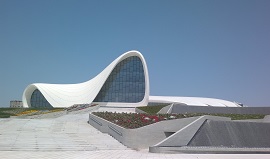Zaha Hadid
Dame Zaha Hadid was an architect known for her high-concept neo-futurist designs that gave her the label 'queen of the curve'. Born in Baghdad in 1950, she became the first woman in her own right to receive the prestigious Pritzker Architecture Prize in 2004, and the RIBA Gold Medal in 2015.
Initially studying mathematics in Beirut, Hadid moved to London in the early 1970s to attend the Architectural Assoication, where she later taught alongside the likes of Rem Koolhaas and Elia Zenghelis. London was to become the base for Zaha Hadid Architects which she founded in 1980. Throughout the 1980s she taught at the Harvard Graduate School of Design and a number of other international universities. During this period she began to be recognised for her innovative use of shapes, skewed perspectives and unusual geometric forms, notably in competition proposals for The Peak terminus in Hong Kong and the Cardiff Bay opera house that was later controversially cancelled.
It wasn't until 1993 that one of her designs was actually realised – the Vitra Fire Station in Germany, however, for all its ambition, it was criticised for its practical unsuitability by the firemen who occupied it. Towards the end of the 1990s, she designed the Mind Zone for the Millennium Dome and the first of the now-annual Serpentine Gallery Pavilion temporary structures.
Developing a reputation for seeking to push the boundaries of architecture and urban design, she experimented with the structural potential of concrete in the form of dramatic curves and angles on projects such as the Bergisel Ski Jump in Innsbruck (2002), and the Rosenthal Center for Contemporary Art in Cincinnati (2003). She also became involved in interior and product design, developing the Moon System Sofa for furniture manufacturer B&B Italia, and working with clothing brand Lacoste.
Perhaps her most famous building work is the Heydar Aliyev Cultural Center in Azerbaijan, with its sculptural skin bulging in smooth white waves. In 2010 and 2011 she won the Stirling Prize for the MAXXI museum in Rome and the Evelyn Grace Academy in London.
Despite many accolades, Hadid was no stranger to controversy, and often faced criticism for extravagant projects that spiraled over budget or were sponsored by states with questionable human rights records. Her design for the London Olympics Aquatic Centre suffered cost overruns, and her scheme for the Tokyo 2020 Olympics Stadium was cancelled due to escalating costs and local objections.
Sadly, Hadid passed away on 31 March 2016 when she was only 65 years old, with major projects ongoing such as the 2022 Qatar World Cup Stadium and a new airport terminal in Beijing.
Most notable buildings:
- Vitra Fire Station, Germany
- Bergisel Ski Jump, Innsbruck
- BMW Central Building, Germany
- MAXXI museum, Rome
- Riverside Museum, Glasgow
- Evelyn Grace Academy, London
- Heydar Aliyev Cultural Centre, Azerbaijan
- Messner Mountain Museum, Italy
- World Cup Stadium, Qatar
[edit] Related articles on Designing Buildings Wiki
- 600 Collins Street, Melbourne.
- Antoni Gaudi.
- Architect.
- Buckminster Fuller.
- Concept architectural design.
- D'Leedon, Singapore.
- Deconstructivism.
- Erno Goldfinger.
- Frank Gehry.
- Frei Otto.
- Masaryk Railway Station regeneration.
- Neo-futurism.
- Norman Foster.
- Parametricism.
- Port House, Antwerp.
- Richard Rogers.
- Salerno Maritime Terminal.
- Ted Happold.
- The architectural profession.
- The Architecture of Neoliberalism.
- UHAC, Saudi Arabia.
- Unusual building design of the week.
[edit] External references
- Zaha Hadid - Official site
Featured articles and news
OpenUSD possibilities: Look before you leap
Being ready for the OpenUSD solutions set to transform architecture and design.
Global Asbestos Awareness Week 2025
Highlighting the continuing threat to trades persons.
Retrofit of Buildings, a CIOB Technical Publication
Now available in Arabic and Chinese aswell as English.
The context, schemes, standards, roles and relevance of the Building Safety Act.
Retrofit 25 – What's Stopping Us?
Exhibition Opens at The Building Centre.
Types of work to existing buildings
A simple circular economy wiki breakdown with further links.
A threat to the creativity that makes London special.
How can digital twins boost profitability within construction?
The smart construction dashboard, as-built data and site changes forming an accurate digital twin.
Unlocking surplus public defence land and more to speed up the delivery of housing.
The Planning and Infrastructure Bill
An outline of the bill with a mix of reactions on potential impacts from IHBC, CIEEM, CIC, ACE and EIC.
Farnborough College Unveils its Half-house for Sustainable Construction Training.
Spring Statement 2025 with reactions from industry
Confirming previously announced funding, and welfare changes amid adjusted growth forecast.
Scottish Government responds to Grenfell report
As fund for unsafe cladding assessments is launched.
CLC and BSR process map for HRB approvals
One of the initial outputs of their weekly BSR meetings.
Building Safety Levy technical consultation response
Details of the planned levy now due in 2026.
Great British Energy install solar on school and NHS sites
200 schools and 200 NHS sites to get solar systems, as first project of the newly formed government initiative.
600 million for 60,000 more skilled construction workers
Announced by Treasury ahead of the Spring Statement.



































